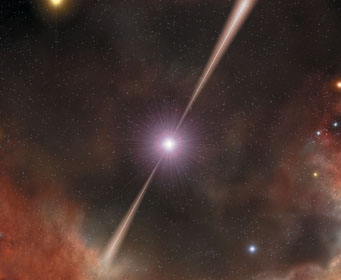
European Southern Observatory
On March 19, 2008, NASA’s Swift satellite captured an intense burst of gamma rays from deep space. But that wasn’t all that was detected. Several ground-based telescopes caught a source of visible light rising until it was bright enough to be seen with the naked eye for nearly a minute. What made this event so amazing was its distance: halfway across the visible universe. Never before has such a distant object risen to naked-eye visibility. The explosion is so far away in space and time that it took place 3 billion years before Earth formed!
This stupendous event was an extreme example of a gamma-ray burst, or GRB. These are incredibly powerful stellar explosions. When the core of a massive star runs out of nuclear fuel, gravity causes it to collapse into a black hole or neutron star. A shock wave is triggered that blows up the star as a supernova. But on rare occasions, the core collapse also leads to the formation of two jets that shoot away in opposite directions at nearly the speed of light. Colliding shells of material in these jets give rise to GRBs, which are among the most violent events in the universe since the Big Bang.
GRBs are incredibly luminous, but the March 19 burst topped the charts. What made this GRB special, and could GRBs pose a threat to Earth? To learn more, listen to this 12-minute interview, as Penn State University astronomers Judith Racusin and Derek Fox talk to S&T editor in chief Robert Naeye. Racusin and Fox led the international effort to analyze the burst. They are also coauthors of a feature article about the burst in the January 2009 issue of S&T.
 0
0
Comments
You must be logged in to post a comment.